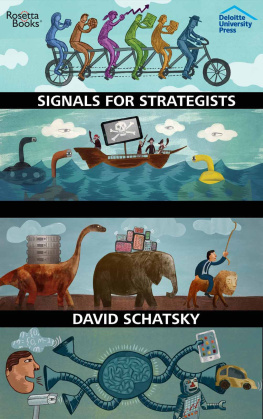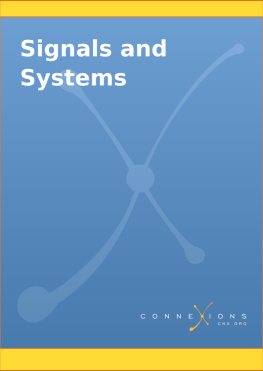

Copyright 2016 by Amy Webb
Published in the United States by PublicAffairs, an imprint of Perseus Books, LLC, a subsidiary of Hachette Book Group, Inc.
All rights reserved.
Printed in the United States of America.
No part of this book may be reproduced in any manner whatsoever without written permission except in the case of brief quotations embodied in critical articles and reviews. For information, address PublicAffairs, 250 West 57th Street, 15th Floor, New York, NY 10107.
PublicAffairs books are available at special discounts for bulk purchases in the U.S. by corporations, institutions, and other organizations. For more information, please contact the Special Markets Department at Perseus Books, 2300 Chestnut Street, Suite 200, Philadelphia, PA 19103, call (800) 810-4145, ext. 5000, or e-mail .
Book design by Jeff Williams
Library of Congress Cataloging-in-Publication Data
Names: Webb, Amy, 1974 author.
Title: The signals are talking: why todays fringe is tomorrows mainstream / Amy Webb.
Description: First edition. | New York: PublicAffairs, [2016] | Includes bibliographical references and index.
Identifiers: LCCN 2016028425 (print) | LCCN 2016039541 (ebook) | ISBN 9781610396677 (ebook)
Subjects: LCSH: Business forecasting. | Strategic planning. | Technological innovations.
Classification: LCC HD30.27 .W39 2016 (print) | LCC HD30.27 (ebook) | DDC 658.4/0355dc23
LC record available at https://lccn.loc.gov/2016028425
First Edition
10 9 8 7 6 5 4 3 2 1
To my daughter, Petra, and to her classmates:
We have entrusted the future to you. Be bold and bright.
CONTENTS

T HE FUTURE DOESNT simply arrive fully formed overnight, but emerges step by step. It first appears at seemingly random points around the fringe of society, never in the mainstream. Without context, those points can appear disparate, unrelated, and hard to connect meaningfully. But over time they fit into patterns and come into focus as a full-blown trend: a convergence of multiple points that reveal a direction or tendency, a force that combines some human need and new enabling technology that will shape the future.
Its something I discovered living in Japan, way back in the twentieth century.

Akihabara District, Tokyo, 1997. The bottom of my jeans were already drenched as I made my way from the subway through the downpour and past a cacophony of cartoon voices and computer-generated swirls of electronica. The sheer amount of information and noise made it hard to concentrate.
I had a map written in Japanese, but that wasnt the problem. The waterlogged paper made it impossible to read the few characters left that hadnt blurred entirely. I found myself under some elevated railroad tracks and standing in front of a nondescript door, but the hacker friend I expected to meet was nowhere in sight. Maybe I was in the wrong place.
I shoved my hands deep into my coat pockets and squeezed past a series of twisting alleys all lined with rows and rows of circuits, motherboards, cables, wire cutters, and tiny plastic parts of all shapes and sizes. More information. More noise. There were no smoking signs everywhere, but that didnt stop the group of men walking ahead of me.
Eventually, I stopped at a tiny electronics shack and tried to read the map again.
Hello, I heard a tentative voice. Are you lost?
He was, it turned out, a computer geek, albeit one who had a couple of decades on most of the folks who make up this species. Tattered back issues of Pasokon Ge-mu and Oh! X magazines were piled up next to disassembled PC towers. I explained that I was trying to find my friend, a regular in Akihabara who was building a new kind of game that could be played on a mobile phone. The corners of his mouth crinkled upward as he motioned me over toward a counter in the back of the store.
On the glass were two small mobile phones. He gave me one and told me to wait. He took the other in his hands and started tapping on the alphanumeric keypad. A moment later, I saw a message flash on my screen.  hello in Japanese. Id used mobile-to-mobile messaging before, but tried to muster a gee-whiz look so as not to offend him.
hello in Japanese. Id used mobile-to-mobile messaging before, but tried to muster a gee-whiz look so as not to offend him.
Then, he sent me another message. This time, the text was blue and underlined. It looked like a web address, but that wasnt possible. It was 1997, and back in America, the most exciting mobile technology was a compact 1G flip phone that had a retractable antenna. This was something entirely different.
Try, he said. I pressed a button and the phone started downloading something.
Wait... is this a ringtone? I asked. Am I on the internet?
On the screen, I moved the cursor down to the link and pressed enter. As I did, all the noise and all that information diffused into decipherable nodes of data. I could hear the signals talking.
This phone in my hand was an experiment on the fringe, a clever hack. I shifted my thought to networks of phones all connecting to the internet, to websites, to the Shinkansen train schedule...
Another signal. If we could receive information, we would necessarily give out our information, toopassively and directly. We would buy train tickets, right from our phones. Network operators would know details about us, what we clicked on, what we downloaded. Service providers would earn revenue based on our usage. They would have incentives to provide more bandwidth and faster speeds...
Another signal. I started thinking about all the other early research Id been hearing about. Japan was on the brink of a much faster mobile network that would allow for more people to connect at once. Increased capacity also meant higher speeds, and for the first time, the ability to send files to other devices...
Another signal. Digital cameras were getting smaller. An engineering professor at Dartmouth was at work on an active pixel image sensor, something so tiny it could be embedded into a pen. Two Japanese companies, Sharp and Kyocera, were trying to put image sensors into their phones. Teenagers had become obsessed with puri-kurabu photo vending machinesthey regularly visited with friends, posing for photos of themselves. Theyd use an interactive screen to decorate the photos with different backdrops and doodles before printing them out as stickers.
I listened as the signals connected me to adjacent nodes. I knew of others who were experimenting with tangentially related projects. A startup in New York City had successfully wrested electronic mailemail, for shortfrom university researchers and turned it commercial. For the first time, everyday people were getting online, transfixed by this new medium and excited about sending fast, short messages between computers within just a few seconds. Commercial email networks were starting to boom, unable to meet demand. At the same time, consumer behavior had started to shift. People expected and received faster communication. They created digital identities with vanity email addresses. They had access to a reply-all commanda futuristic megaphone that broadcast their messages to large, engaged audiences.
Next page
















 hello in Japanese. Id used mobile-to-mobile messaging before, but tried to muster a gee-whiz look so as not to offend him.
hello in Japanese. Id used mobile-to-mobile messaging before, but tried to muster a gee-whiz look so as not to offend him.